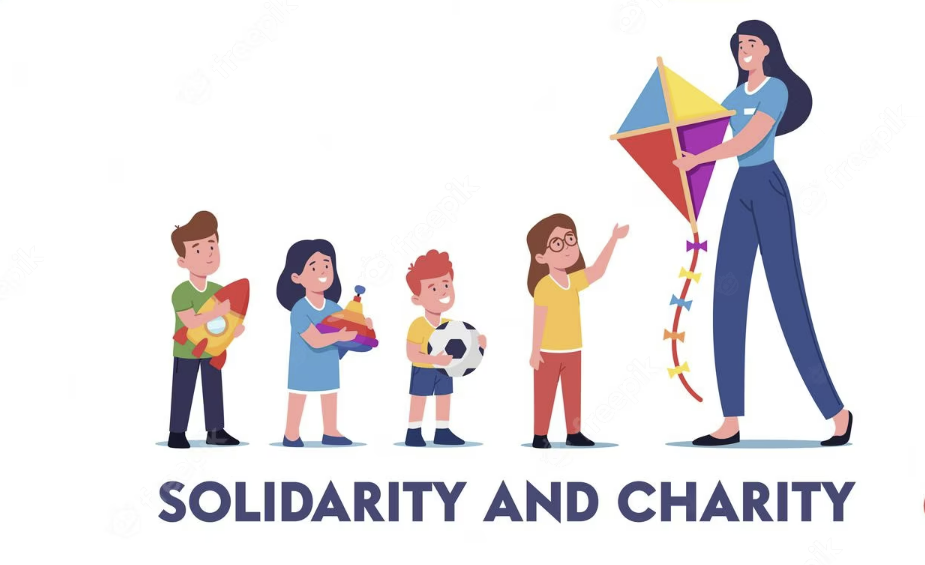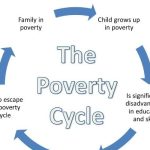Break the cycle of poverty for children
Breaking the cycle of poverty for children is a multifaceted endeavor that requires comprehensive approaches addressing various social, economic, and environmental factors. Across the globe, millions of children are born into circumstances of extreme deprivation, facing barriers that impede their access to education, healthcare, and economic opportunities. Poverty not only deprives children of their basic needs but also limits their potential for growth and development, trapping them in a vicious cycle that persists across generations. To break this cycle, concerted efforts are needed to address the root causes of poverty, empower children and families with the resources and opportunities they need to thrive, and create an environment that fosters equity, inclusion, and social justice. Through strategic interventions in areas such as education, healthcare, economic empowerment, infrastructure development, psychosocial support, advocacy, and community development, we can work together to create a brighter future for children and break the intergenerational cycle of poverty.

How charities can break the cycle of poverty for children through Education and Skill Development
Charities can break the cycle of poverty for children through education by funding and establishing educational programs that provide consistent, quality learning opportunities. This can include building and maintaining schools in underserved areas, providing scholarships and financial aid to students who cannot afford school fees, and supplying necessary learning materials such as textbooks, uniforms, and technology. By ensuring that children have access to a stable and supportive educational environment, charities help them gain the foundational knowledge and skills required for future employment and economic independence. Education empowers children with critical thinking abilities, broadens their horizons, and significantly increases their chances of breaking free from the cycle of poverty that has trapped previous generations.
In addition to traditional education, charities can focus on skill development programs tailored to the needs of the community. This involves offering vocational training, apprenticeships, and skill-building workshops that align with local job markets and economic opportunities. For example, charities might provide training in trades such as carpentry, plumbing, or computer programming, which can lead to immediate employment. Furthermore, by offering entrepreneurial training and microloans, charities can support young adults and their families in starting small businesses, thereby creating local employment opportunities. These programs not only equip individuals with practical skills but also foster a sense of self-reliance and entrepreneurship, essential for long-term economic stability and community development. Through these focused educational and skill development initiatives, charities can create a robust framework for children and their families to escape poverty and build a sustainable future.
breaking the cycle of poverty for children through Health and Nutrition
Charities can break the cycle of poverty for children through health and nutrition initiatives by ensuring that children receive the essential healthcare and nourishment they need for proper physical and cognitive development. This can be achieved by establishing medical clinics in underserved areas, funding vaccination and preventive healthcare programs, and providing access to essential medicines. Regular health check-ups, dental care, and mental health services are also crucial to address the comprehensive health needs of children. By keeping children healthy, these programs reduce absenteeism in schools due to illness and allow children to focus better on their studies, ultimately improving their educational outcomes and future prospects.
In addition to healthcare, addressing malnutrition is vital in breaking the cycle of poverty. Charities can implement school feeding programs that provide children with nutritious meals, ensuring they have the energy to learn and grow. These programs can be complemented by community nutrition education initiatives that teach families about balanced diets and sustainable agricultural practices. Charities can also support the establishment of community gardens and local food production projects to improve food security. By ensuring that children receive adequate nutrition, charities help prevent the long-term health and developmental issues associated with malnutrition, thereby giving children a better chance to succeed academically and escape the cycle of poverty.
breaking the cycle of poverty for children through Economic Empowerment
Charities play a crucial role in breaking the cycle of poverty for children through economic empowerment initiatives that focus on providing families with the tools and resources to create sustainable livelihoods. One effective strategy is to offer microfinance programs that provide small loans to parents, particularly women, to start or expand their own businesses. These loans can be used to invest in income-generating activities such as farming, handicrafts, or small-scale retail. By empowering parents to generate their own income, these programs not only alleviate immediate financial hardships but also foster a sense of agency and self-reliance within families, ultimately breaking the cycle of dependency on aid.

Moreover, charities can support vocational training programs that equip youth with the skills and expertise needed to access better employment opportunities. By partnering with local industries and businesses, charities can tailor training programs to the specific needs of the job market, ensuring that participants acquire relevant skills that lead to sustainable employment. Additionally, entrepreneurship training can help young adults develop the knowledge and confidence to start their own businesses, creating jobs not only for themselves but also for others in their communities. By investing in economic empowerment initiatives, charities empower families to build assets, increase their incomes, and break free from the intergenerational cycle of poverty, thereby creating a brighter future for children and their communities.
breaking the cycle of poverty for children through Infrastructure Development
Breaking the cycle of poverty for children through infrastructure development involves improving access to essential services and creating a supportive environment for their growth and development. Charities can contribute to this by investing in infrastructure projects such as building schools, healthcare facilities, and sanitation systems in underserved communities. By providing access to quality education, healthcare, and sanitation, these projects address the immediate needs of children and lay the foundation for their long-term well-being and success.
Furthermore, charities can support initiatives to improve access to clean water and sanitation facilities, which are essential for preventing waterborne diseases and promoting good hygiene practices. By building wells, installing water purification systems, and constructing latrines, charities can ensure that children have access to safe drinking water and sanitation facilities, reducing the risk of illness and improving overall health outcomes.
Additionally, infrastructure development projects can include initiatives to improve transportation and communication networks, making it easier for children and families to access essential services and economic opportunities. By building roads, bridges, and telecommunications infrastructure, charities can connect remote communities to markets, schools, and healthcare facilities, opening up new possibilities for children and their families.

Overall, infrastructure development plays a crucial role in breaking the cycle of poverty for children by creating the conditions for their health, education, and economic empowerment. Through strategic investments in infrastructure projects, charities can help create a more equitable and prosperous future for children and communities around the world.
breaking the cycle of poverty for children through Psychosocial Support:
Breaking the cycle of poverty for children through psychosocial support involves addressing the emotional and psychological needs of children and families living in poverty, helping them overcome the challenges associated with their circumstances and build resilience. Charities can provide various forms of psychosocial support to children and families, including counseling, therapy, mentorship, and community support programs.
One way charities can offer psychosocial support is by providing counseling and therapy services to children and families experiencing trauma, stress, or mental health issues due to poverty-related factors such as violence, abuse, or instability. By offering a safe space for children to express their emotions and learn coping strategies, these programs help them develop resilience and emotional well-being, enabling them to better navigate the challenges they face.
Additionally, charities can implement mentorship programs that pair children with positive adult role models who can provide guidance, encouragement, and support. Mentors can help children set goals, build confidence, and develop life skills, empowering them to overcome obstacles and pursue their dreams despite the challenges they may face.
Furthermore, community support programs that bring families together to share experiences, resources, and emotional support can create a sense of belonging and solidarity, reducing social isolation and strengthening social networks. By fostering connections within the community, these programs help children and families access the support they need to thrive despite the challenges of poverty.
Overall, psychosocial support plays a crucial role in breaking the cycle of poverty for children by addressing the emotional and psychological barriers that can impede their ability to succeed. By providing counseling, mentorship, and community support, charities help children and families build resilience, develop coping strategies, and forge positive relationships, empowering them to overcome adversity and create a brighter future for themselves and future generations.
breaking the cycle of poverty for children through Advocacy and Policy Change
Breaking the cycle of poverty for children through advocacy and policy change involves addressing systemic barriers and inequalities that perpetuate poverty and hinder children’s access to opportunities and resources. Charities can advocate for policies that prioritize the needs of children and families living in poverty, promote equitable access to education, healthcare, and social services, and address root causes of poverty such as discrimination, inequality, and lack of opportunity.
One way charities can advocate for children living in poverty is by raising awareness about the challenges they face and mobilizing public support for policy changes that improve their well-being. This may involve conducting research, organizing campaigns, and engaging with policymakers to highlight the impact of poverty on children and advocate for solutions that address their needs.
Additionally, charities can work to influence policy at the local, national, and international levels by collaborating with government agencies, lawmakers, and other stakeholders to develop and implement policies that promote child rights, protect vulnerable populations, and create opportunities for children and families to thrive. This may include advocating for increased funding for education, healthcare, and social services, as well as policies that address the underlying factors contributing to poverty, such as affordable housing, living wages, and access to quality jobs.
Furthermore, charities can support community-based advocacy efforts that empower children and families to participate in decision-making processes, advocate for their own needs, and hold policymakers accountable for addressing the root causes of poverty and inequality. By amplifying the voices of those directly affected by poverty, charities can help shape policies and programs that better meet the needs of children and families living in poverty, ultimately breaking the cycle of poverty and creating a more equitable and just society for all.
breaking the cycle of poverty for children through Community Development
Breaking the cycle of poverty for children through community development involves empowering communities to address the root causes of poverty and create sustainable solutions that promote the well-being of children and families. Charities can support community development initiatives by working collaboratively with local residents, organizations, and government agencies to identify priorities, mobilize resources, and implement programs that address the unique needs and challenges of each community.
One way charities can promote community development is by supporting grassroots organizations and community-led initiatives that empower residents to take ownership of their own development. This may involve providing funding, technical assistance, and capacity-building support to help local organizations develop leadership skills, build partnerships, and implement projects that address pressing social, economic, and environmental issues.
Additionally, charities can facilitate community engagement and participation by organizing community meetings, forums, and workshops where residents can come together to discuss their concerns, share ideas, and collaborate on solutions. By creating opportunities for dialogue and collaboration, charities help foster a sense of collective responsibility and solidarity within the community, empowering residents to work together to address common challenges and create positive change.
Furthermore, charities can support economic development initiatives that create opportunities for sustainable livelihoods and economic empowerment. This may involve supporting small businesses, cooperatives, and social enterprises that provide job training, employment opportunities, and access to markets for local producers. By strengthening the local economy and creating pathways to prosperity, these initiatives help lift families out of poverty and create a more vibrant and resilient community.
Overall, community development plays a crucial role in breaking the cycle of poverty for children by addressing the underlying social, economic, and environmental factors that contribute to poverty and inequality. By empowering communities to take ownership of their own development and create positive change, charities help create a more inclusive, equitable, and sustainable future for children and families.
read more: What is charity-boosted urban-rural linkage?




